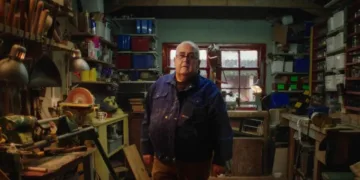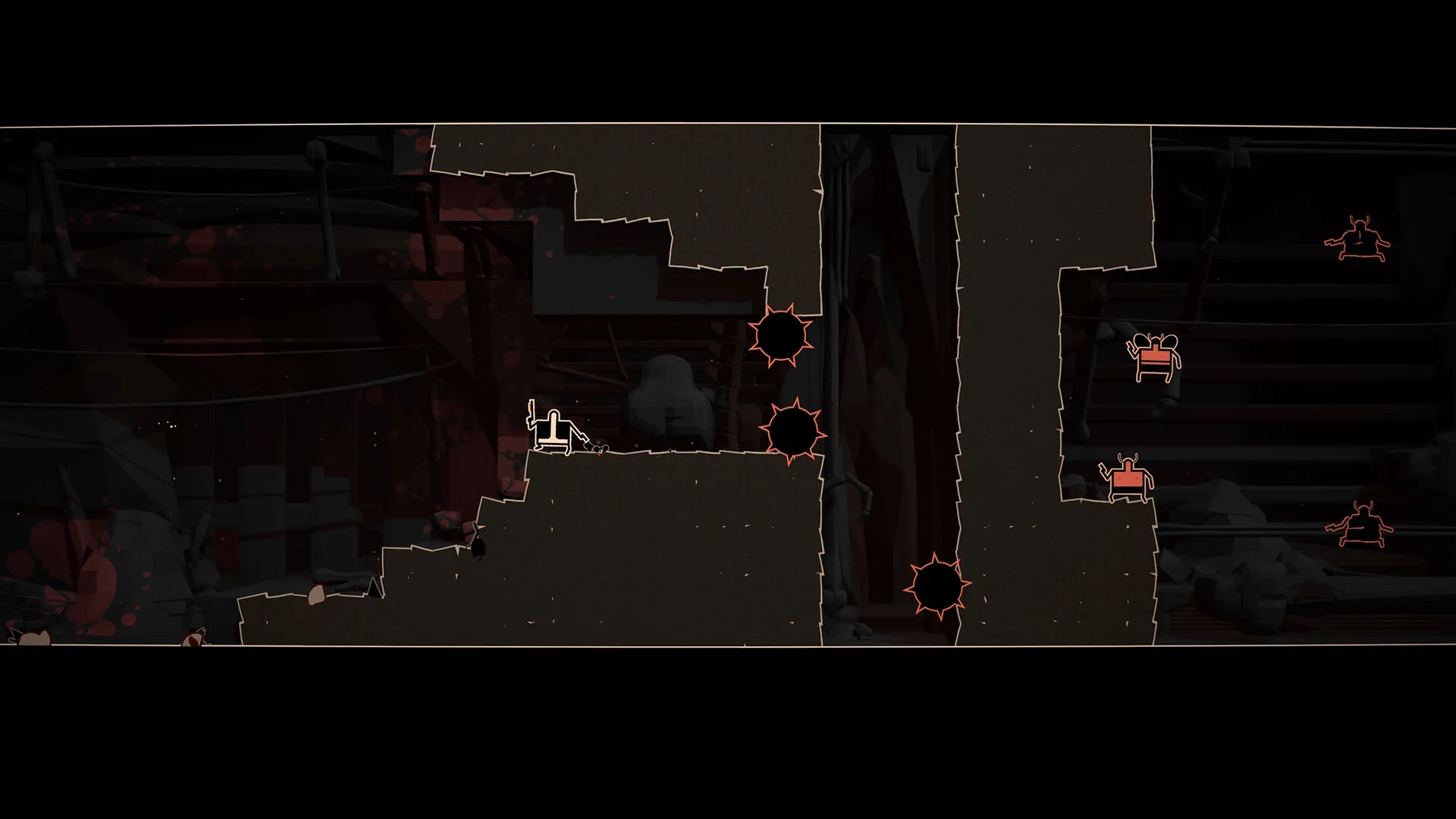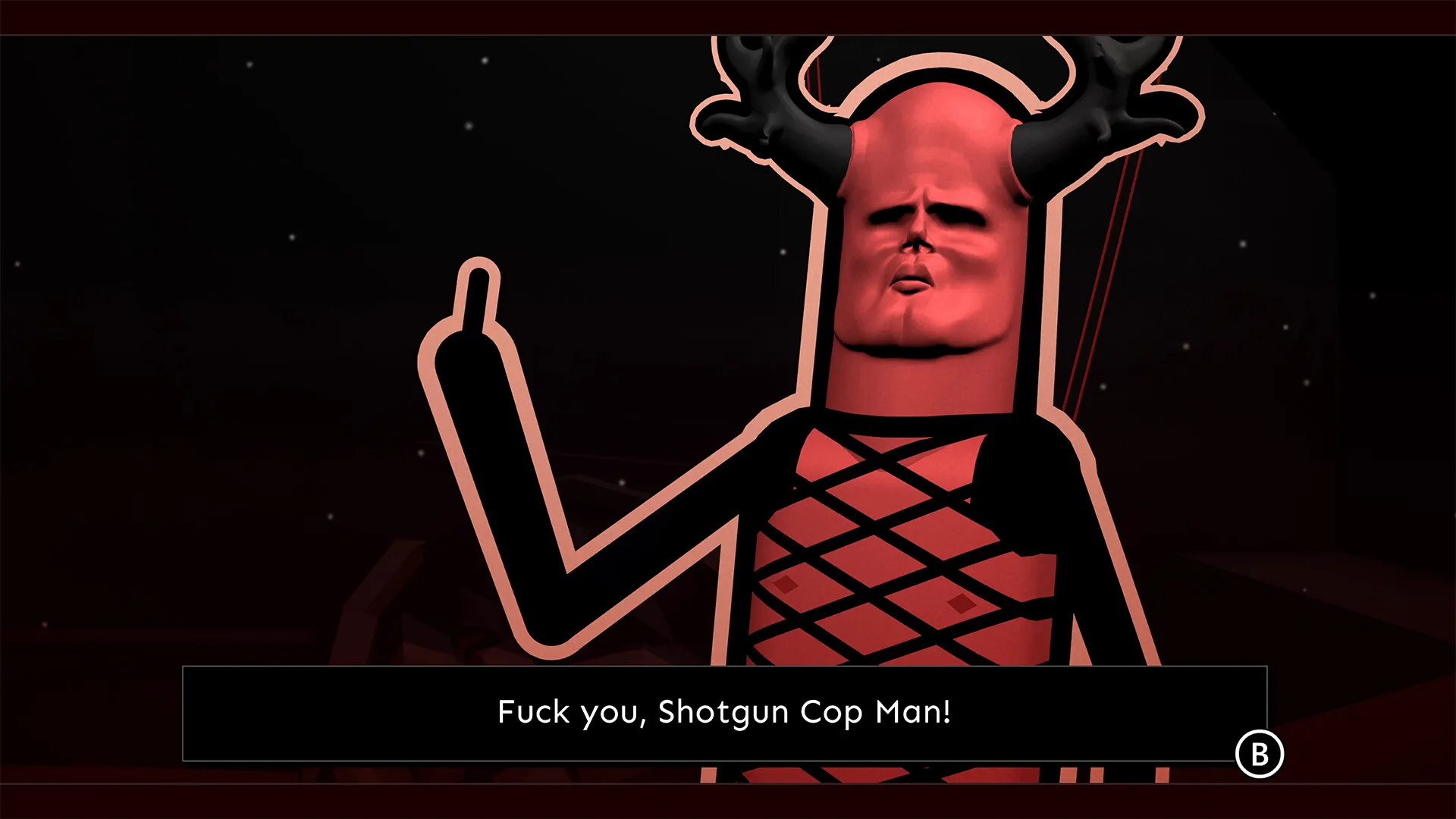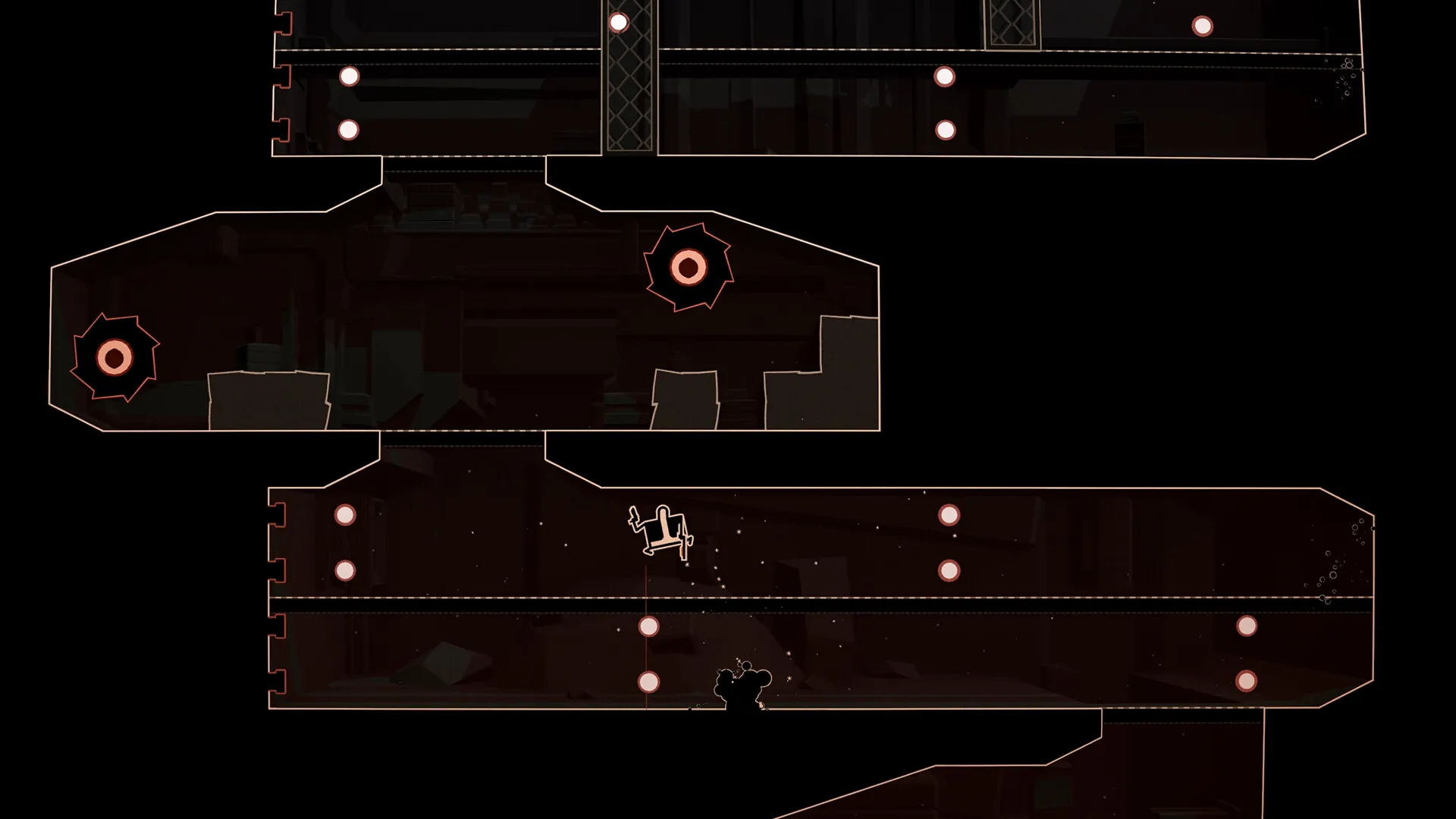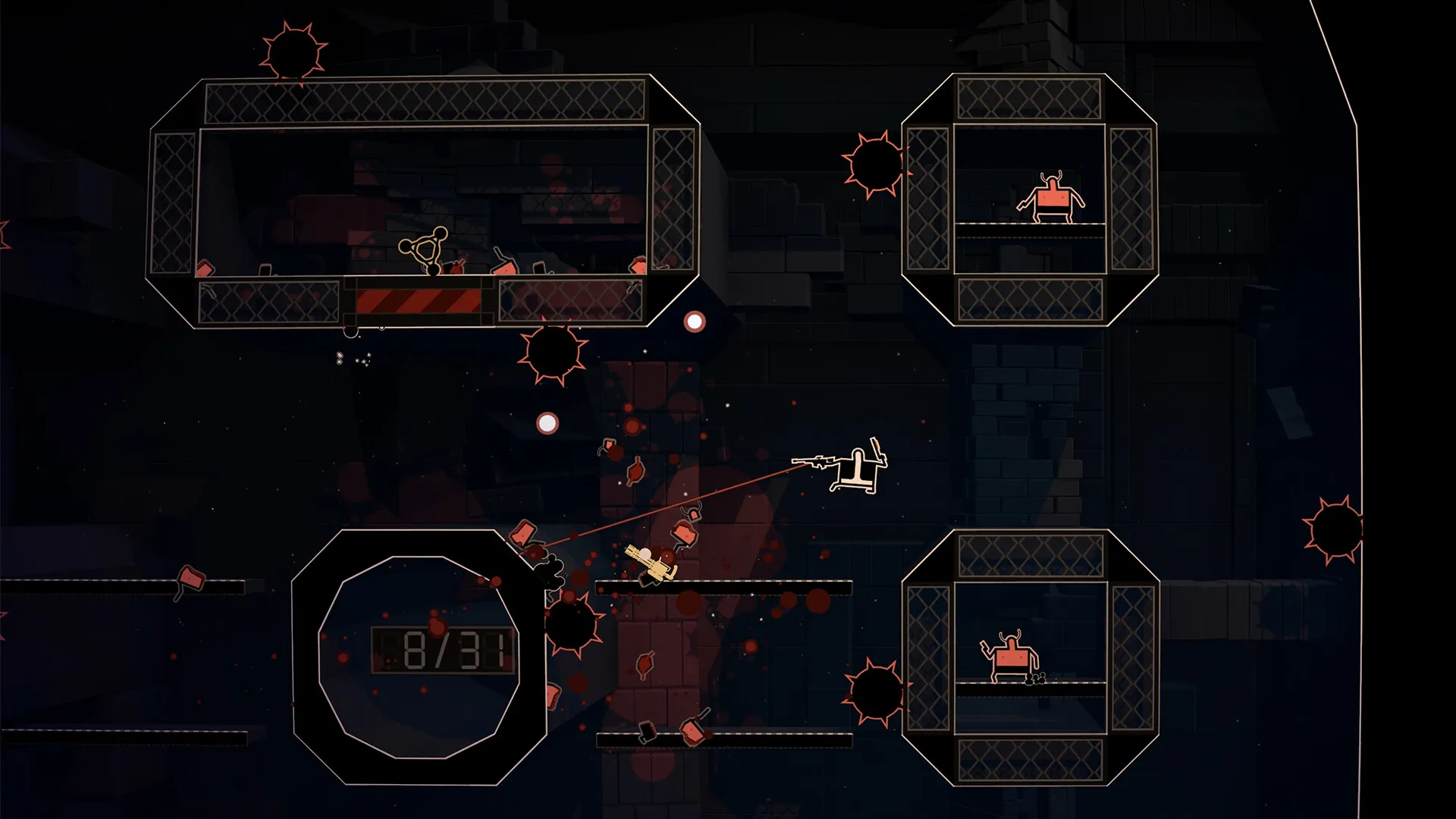From the moment you grasp Shotgun Cop Man’s shotgun, it’s clear that this isn’t a typical platformer. You embody a plucky, metallic-voiced officer dispatched straight into Hell’s corridors on a mission to arrest Satan himself. Story scenes are scarce—brief cutscenes of your demand and his defiant flip of the bird—but what it lacks in narrative depth it makes up for in unapologetic action. The game wears its tongue-in-cheek attitude on its sleeve, leaning into absurdity rather than exposition.
Developed by Swedish indie studio DeadToast Entertainment, this release follows the cult success of My Friend Pedro and refines its creator’s flair for fluid, physics-driven gameplay. Available on PC, Nintendo Switch, and other consoles, the PC edition also boasts a built-in level editor for community creations—an option absent on Switch, where the focus remains squarely on the campaign.
At its core, Shotgun Cop Man hinges on an ingenious twist: your shotgun’s recoil doubles as your jump mechanic. Firing in one direction rockets you the opposite way, transforming every enemy encounter into a navigational puzzle. Think of it as Celeste’s precise momentum meets Super Meat Boy’s rapid restarts, but fuelled entirely by firearms.
Over roughly nine worlds—each containing about 17 bite-sized stages—you’ll blaze through traps, demons, and saw blades in three to five hours of playtime. These short bursts deliver a steady stream of fresh challenges, ensuring that no two levels ever feel identical.
Propulsive Momentum at Play
Shotgun Cop Man’s signature move is its recoil-driven movement, which replaces a traditional jump with every blast of the shotgun. Firing downward or backward sends you careening through the air, creating a dance of momentum and gravity that demands precision timing. Early levels teach you to gauge shot angle and power almost like learning a dash in Celeste, but here your trajectory depends on kickback physics rather than a scripted ability. That initial sense of unpredictability gives way to a rewarding grasp of inertia once you internalize how each shell shifts your arc.
Your secondary weapon serves as both a combat tool and an aerial stabilizer. While the shotgun packs only three rounds before a ground-only reload, sidearms like pistols or miniguns refill your shotgun clip by scoring aerial kills. This interplay transforms each stage into a rhythmic loop: blast, kill, relaunch, repeat. Because ammo is unlimited but clip-limited, you’re constantly weighing the choice between a powerful propulsion burst and a lighter volley that keeps you aloft longer—an element that feels more strategic than the binary jump-versus-shoot design in run-and-gun classics like My Friend Pedro.
Levels pepper in moving platforms, spinning saw blades, and “reactive floors” that switch safe zones on each shot, requiring you to treat enemies as traversal hazards rather than mere targets. A demon perched on a narrow ledge isn’t just a threat; it’s your launchpad. This fusion of obstacle and foe recalls the way Super Meat Boy uses spikes and boxes to guide your momentum, but here the environment twists based on your own firepower.
Shotgun Cop Man unfolds its mechanics in bite-sized bursts across worlds. Each new chapter introduces fresh elements—sticky surfaces, explosive barrels, even arena-style combat rooms—while optional challenges like time-trials, full-clear runs, and no-hit goals keep you honing routes long after the main path is clear. This careful ramp-up ensures that by world three or four, you’re chasing split-second optimizations with the same zeal as speedrunners chasing pixel-perfect glory.
Versatile Firepower and Tactical Trade-Offs
Shotgun Cop Man’s primary weapon wears two hats: it’s your rocket-jump engine and your main source of damage. With only three shells per clip, you must choose whether to fire all at once for a soaring burst of speed or pace your shots into controlled hops. Each refill demands a grounded moment, turning every reload into a brief strategic pit stop. This mechanic echoes the momentum juggling in Super Meat Boy, but here your trajectory is directly tied to your offensive choices.
Your sidearm complements this system by offering a spectrum of playstyles. Early on, a basic pistol delivers quick, light kicks that help you hover; later, you’ll swap in a minigun or Uzi for rapid-fire midair adjustments, or even a flamethrower for close-range crowd control. Each secondary weapon varies in fire rate and recoil strength, so picking the right tool becomes a balancing act: powerful guns refill your shotgun by scoring kills, but heavy recoil can send you careening off-course.
Enemies serve a dual purpose as both threats and platforms. One-hit kills force you to manage health via the floating heart pickup, a design that softens stingy check-pointing without trivializing risk. Placing foes near spikes or on moving platforms turns every encounter into a puzzle: do you clear them for a refill, or treat them as makeshift boosts to clear an obstacle? This push-and-pull between ammo management and traversal choice sits at the heart of Shotgun Cop Man’s tactical depth.
Structured Chaos in Level Design
Shotgun Cop Man unfolds over roughly ten worlds, each packed with seventeen bite-sized stages that clock in under a minute once you’ve mastered the basics. This structure mirrors Super Meat Boy’s chapter breakdown—short, focused bursts that let you learn, fail fast, and iterate—but with an underworld twist. Visually, stages lean into industrial, gothic motifs: pitch-black platforms set against dim, hellish backdrops. While this consistency reinforces the game’s hellscape atmosphere, it occasionally veers into monotony, as each world feels cut from the same dark cloth.
What keeps the pacing lively is a disciplined rollout of level gimmicks. Early worlds introduce the shotgun’s basic recoil movement, then layer on moving platforms and spinning saws. By world three, you’ll contend with reactive floors that toggle safe zones each time you shoot—an echo of Celeste’s disappearing blocks that forces you to think twice before blasting. Later chapters toss in box-pushing puzzles, where you must leverage specific weapon strength to shift obstacles, and arena-style combat rooms that feel like Hotline Miami meets a platformer: loot the area, then use your secondary weapon to hover through a gauntlet of bullets.
Every world culminates in a boss encounter that tests your mastery of its signature mechanics. You’ll face multi-phase demons that teleport across platforms, spawn swarms of fodder enemies, and punish stray shots with area-denial attacks. These battles stand apart from regular stages by requiring sustained movement planning under fire—think Spider-Tank boss in My Friend Pedro, but distilled into pixel-perfect, shotgun-propelled jumps.
For PC players, the built-in level editor extends the core design toolkit. It exposes the same reactive panels, enemy spawns, and trap mechanics used in the campaign, plus a handful of exclusive components for community creations. While aesthetic customization is limited, the depth of mechanical options promises a steady stream of user-crafted challenges, much like the thriving Celeste and Super Mario Maker mod scenes.
Intuitive Controls and Accessibility Refinements
Shotgun Cop Man leans on a twin-stick setup that feels more at home in a top-down shooter than a platformer: the left stick handles movement while the right aims your weapons. At first, this split focus can feel like rubbing your belly and patting your head simultaneously, as you circle-strafe demons while trying to blast off the ground. After a couple of hours, however, muscle memory kicks in and the scheme becomes second nature—much like mastering dual-stick gunplay in Helldivers, except here your bullets power every jump.
Recognizing the learning curve, the game offers a suite of accessibility toggles. You can enable automatic weapon pickups to avoid fumbling for buttons midair or simplify reload inputs so that touching down triggers a shotgun refill without extra presses. These options echo Celeste’s assist mode philosophy by letting players tailor challenge to comfort, and customizable button remapping ensures that both left- and right-handed controllers work seamlessly.
The UI flow is built around rapid failure and retry. Checkpoints crop up at forgiving intervals, so most deaths drop you mere seconds from where you fell. That said, performing a full level restart requires multiple menu hops—pause, select retry, confirm—whereas Super Meat Boy’s one-press respawn feels markedly snappier. A dedicated quick-restart button would have tightened pacing during obsessive time-trial runs.
On Switch, performance is rock-steady: frame-rate only stutters when explosions, enemies, and traps converge in a single frame, and load times hover near instantaneous. Level transitions blur into each other, maintaining momentum even when the action pauses for a heart-recovery vignette. Overall, the presentation’s polish keeps frustration in check, letting you focus on refining each airborne shot.
Striking Audio-Visual Presentation
Shotgun Cop Man’s aesthetic channels the tight sprite work of Super Meat Boy, with compact character models framed against sprawling, dimly lit backdrops. Platforms and hazards pop in stark contrast—jet-black ledges and bright saw blades stand out clearly, ensuring split-second jumps aren’t hampered by visual clutter. While the industrial, underworld motif remains consistent across worlds, a handful of color swaps (blood-red accents in one chapter, sickly green floors in another) help differentiate stages just enough to prevent total repetition.
Animation plays a crucial role in feedback. The explosive recoil kick of the shotgun feels weighty, with Cop Man’s arms jolting backward in sync with each blast. Death sequences zoom in tightly on his comical face as he croaks “I DIE,” then catapults his heart into view—an overture to the floating health pickup. Weapon impacts register with satisfying splatters and sparks, making every midair kill as gratifying visually as it is mechanically.
The audio design underlines that blend of absurdity and aggression. A punchy bass-driven soundtrack thumps between levels, evoking the adrenaline rush of Hotline Miami but without drowning out in-game cues. Shotgun blasts crack sharply, and ricochet pings give spatial context to your surroundings. When you lose your heart, the world’s audio filters into a muffled, underwater haze—an immediate, intuitive warning that recalls Celeste’s slowed-down ghost effects.
Together, these elements reinforce Shotgun Cop Man’s off-kilter charm: a violent, physics-fueled ballet that never sacrifices readability or tone for style.
Replayability & Additional Features
Each stage in Shotgun Cop Man comes with a trio of optional objectives—beat the par time, clear every enemy, and survive without taking damage—that transforms a brief run into a deeper puzzle. Checking off all three feels as addictive as perfecting a Super Meat Boy level, and while there’s no global leaderboard baked in, the game tracks your personal bests, encouraging you to shave off milliseconds on each map.
Those bite-sized levels are perfect for speedrunners: you’ll blitz through most stages in under a minute, refining routes and weapon combos until your runs feel seamless. However, the absence of a one-button quick-restart slightly undercuts this flow; repeated deaths force you into pause menus and multiple confirmations, a small annoyance when you’re chasing pixel-perfect splits.
On PC, the built-in level editor extends the core mechanics into community creations. It exposes the same reactive floors, enemy spawns, and physics props from the campaign, plus a handful of editor-only elements. Though you can’t tweak visuals or soundtrack, the depth of mechanical customization promises a steady influx of inventive user levels—think Celeste’s B-side fan maps, but fuelled by shotgun recoil.
With a five-hour main campaign and dozens more hours for completionists, Shotgun Cop Man appeals to both casual players and precision fanatics. Its framework for challenges and user-generated content suggests a vibrant post-launch scene, bridging the gap between a quick action fix and a long-term obsession.
The Review
Shotgun Cop Man
In short, Shotgun Cop Man delivers a fierce, physics-driven platformer built around shotgun recoil as movement. Its tight mechanics and bite-sized stages shine, though visual sameness and the lack of a one-button restart limit its polish. With a compelling challenge loop and a robust PC editor, it balances quick thrills and long-term depth.
PROS
- Innovative recoil-based movement that turns guns into rocket-jumps
- Tight, short stages ideal for speedruns and precision play
- Engaging ammo-management loop between shotgun blasts and sidearm kills
- Ample content with ten worlds and a PC-only level editor
- Solid performance with smooth frame-rates and quick load times
CONS
- Visual palette stays largely the same from level to level
- No single-button quick-restart slows down retry loops
- Steep learning curve for twin-stick recoil controls
- Environment themes feel repetitive across chapters



























